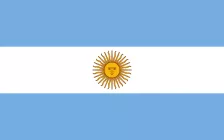Argentina

Geographical Location of Argentina
Argentina is located in South America and borders Chile to the west and south, Paraguay and Bolivia to the north, and Brazil and Uruguay to the east. The country has a long coastline to the Atlantic Ocean. With the exception of the Andes in the west, most of the landscape is lowlands and large flat plains. The lowlands are divided into three main areas: the northern part, the pampas and Patagonia. The northern part is characterized by large grasslands, the pampas has good conditions for agriculture and animal husbandry, and Patagonia is a plateau with an altitude of up to 1500 meters above sea level. In the north, on the border with Brazil, are the Iguazu Falls. The waterfall is a major tourist attraction and is listed as a UNESCO World Cultural and Natural Heritage Site.
Argentina extends far geographically and has a varied climate. In most of the country the climate is temperate, but in the far north it is tropical, and in the south it is subarctic. Pollution and loss of agricultural land due to industrial emissions and pesticide use are the main environmental issues the country is grappling with. Much of the country's land has also been destroyed due to deforestation and desertification.
Brief History of Argentina
The oldest traces of human habitation in Argentina date back to 11,000 BC. The country had Native American settlements in the north and scattered populations of hunter-gatherers in the south until the Spanish colonized the country in 1516. Forced labor and disease from Europe led to the deaths of many of the country's indigenous population. The country was part of the Viceroyalty of Peru and the Viceroyalty of Rio de la Plata before becoming independent in 1816. The period following independence from Spain was characterized by internal unrest. There were disagreements between conservative and liberal politicians, as well as between politicians and the military. Between 1880 and 1910, the country was ruled by conservative politicians. Agriculture was developed, and meat and grain were important commodities. There was a need for labor, which opened the way for immigration from Europe. With European immigrants came the ideas of socialism, and work was done to combat inequality in society.
In 1946, Juan Peron came to power. He improved the lot of the poor, gave women the right to vote and nationalized industry. At the same time, he ruled with dictatorial methods; opposition was suppressed and the media was controlled. In 1955, Perón was overthrown in a military coup, and until 1976 the country's political leadership was determined by the military. During the years of the military dictatorship, up to 30,000 people disappeared, and the country's external debt grew sharply. In 1982, Argentine forces invaded the British Falkland Islands in the South Atlantic but lost to British forces. The defeat led to the fall of the military dictatorship and the holding of the country's first democratic elections. The 2000s were characterized by several periods of economic downturns and great public discontent.
Society and Politics of Argentina
Argentina is a republic consisting of 23 provinces, in addition to the capital Buenos Aires. It is a federal system of government with partially autonomous provinces. The president is elected every four years and can serve a maximum of two consecutive terms. In theory, the president's actions should be controlled by Congress, but in practice, power rests with the president. The country's population has little faith in the political system, largely due to corruption.
Much policy attention has been focused on narrowing the gap between rich and poor, giving the state a greater role in business, making Argentina more attractive to foreign investors and combating corruption, which is a serious problem in the country. It also emphasizes expanding cooperation with neighboring countries in order to reduce US influence in the region.
In 2017, it was estimated that approximately one in four Argentines live below the poverty line, and there are large disparities between rich and poor. Some of the rich live in Buenos Aires and other major cities, while the poor mostly live in slums on the outskirts of cities.
Argentina is a member of the UN and specialized UN organizations such as the World Bank and the World Trade Organization.
Economy and Trade of Argentina
A century ago, Argentina was one of the ten richest countries in the world, but failed economic policies and corruption caused the Argentine currency to lose much of its value. In 2001, the country was in an economic crisis and people were unable to withdraw their savings from the bank. The country went bankrupt. This sparked several mass demonstrations and several presidential changes in a short time. The economy eventually recovered, but the country took out new loans and experienced another economic crisis in 2014 when the country was unable to repay its loans. In 2018, Argentina applied for a $50 billion crisis loan from the International Monetary Fund. Despite the credit crisis, the value of the Argentine currency continues to decline and inflation remains high.
Most of Argentina's arable land is used for agricultural production, and this industry accounts for the majority of the country's exports. Argentina is one of the world's largest beef exporters. In addition, the country exports soybeans, corn, fruits, gas, oil and biodiesel. High international commodity prices mean Argentina earns well: in 2017, the country exported goods totaling US$58.4 billion. Argentina's most important trading partners are Brazil, the United States and Chile.







